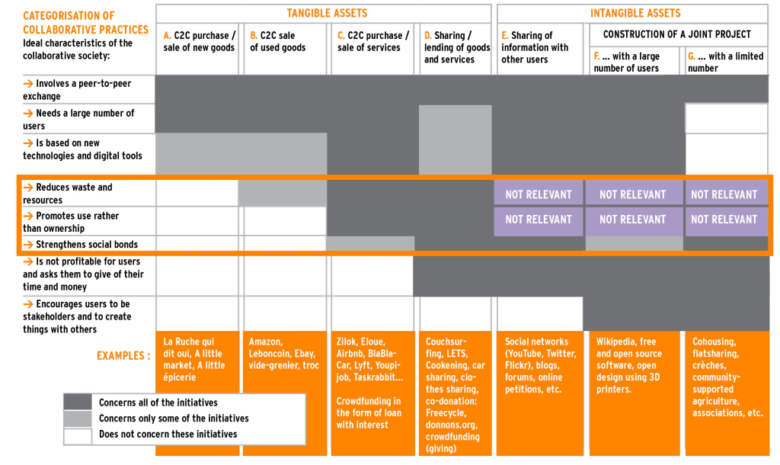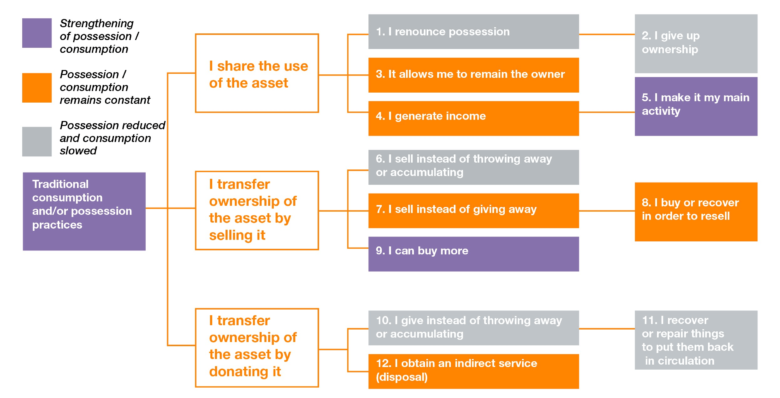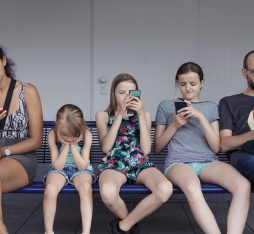The writers who advocate collaborative consumption, and the collaborative economy (a.k.a. the sharing economy) in general, see the movement as a way of boosting sustainable development by making use of resources that are lying dormant and encouraging shared use rather than endless acquisition. Therefore, they argue, collaborative consumption reduces waste and thus steers us away from hyperconsumerism. These are the virtuous effects Rachel Botsman is referring to when she says “we can reshape those forces (of consumerism) to create a healthier, more sustainable system with a more fulfilling goal than ‘more stuff’“. Anne-Sophie Novel expresses the same intention when she states that “the co-revolution brings with it the advent of sustainable development and a new way of being together and building a society“.
Ideological roots that are more digital than environmentalis
There is a great deal of controversy surrounding sustainable development and Collaborative consumption occupies an unusual place in that debate. It is clearly not part of the «green techs» movement, which seeks an answer to the damage caused by previous generations in technology. However, it does make use of digital technology to organize transactions.
Parallels can be drawn between the environmental positioning of collaborative consumption and that of two other trends: the economy of functionality and PSS – Product Service Systems. The environmental virtues of all these approaches lie in their replacement of transfer of ownership with access to usage: in the economy of functionality a business rents out its equipment instead of selling it, while in PSS it transforms it into a service. Thus, businesses are incentivised to produce goods that last, rather than building in obsolescence. The major difference with collaborative consumption is that the resource made available to a third party is owned by an individual, not a business. By learning to share resources, individuals could learn to adopt a lifestyle that shuns acquisitive accumulation in favour of frugality.
Collaborative consumption probably owes more to the imagination of the digital world than that of environmentalists: the terms “collaborative” and “sharing” belong to the tradition of the inventors of the foundational digital technologies – PCs, online communities, the distributed web, etc. For Stewart Brand, Kevin Kelly, Steve Wozniak and other founding figures of the digital world, these technologies constitute vectors for individual and collective emancipation, cooperative practices built around the sharing of one essential resource: information. In this respect, the sharing economy is the new avatar of a utopia born in the US counterculture of the 1970s and ‘80s. Rachel Botsman is following in the footsteps of those web utopians, seeing digital technology as an opportunity to empower the consumer. She applies the notion of sharing not just to information, but also to material resources, calling upon digital technology as a facilitator.
Services and players which distance themselves from environmental promises
In order to compare the environmental good intentions often ascribed to it with the reality of collaborative consumption, we conducted a three-phase study.
First of all, we observed the various collaborative consumption platforms. From these observations, it emerged that many such platforms made no contribution whatsoever to fostering a more environmentally responsible form of consumption. That is simply not their purpose. The analysis conducted by CREDOC (Research Centre for the Study and Monitoring of Living Standards) in 2014 came up with the same findings: across the 7 categories of tangible and intangible goods identified, a reduction in resource waste through platform use is only possible for three categories, while the substitution of usage for ownership is only possible in two cases (see Figure 1).

Figure 1 – Credoc’s categorisation of collaborative practices
Secondly, during our interviews with platform managers, we made sure we got them to talk about how attached they felt to the promised benefits of collaborative consumption. Most of them distanced themselves from the line taken by the initial promoters, or even categorically rejected it. When they do refer to those initial promises, they demonstrate a certain lucidity about the environmental impact of their service. Drivy’s Communications Director explains that «there is the environmental side of it – saying to ourselves that our aim is to put an end to single-occupant cars, to stop producing lots of cars that we don’t need, and to keep them off the road. These services serve to challenge the supremacy of the private car and will eventually help us to do without it. The problem is that, even though it means fewer cars are produced, it also means that existing cars are driven more. That’s why it’s quite difficult to make the environmental argument.».
Thirdly, we focused on users’ practices and perceptions. The results will be disappointing for those seeking a clear and definite conclusion on the sustainable potential of collaborative consumption. This survey provides a perfect illustration of the fact that when usage practices and digital technologies interact, the results are impossible to predict.
One recurring theme, irrespective of the type of transaction involved – sale, rent, donation, etc. – was a desire “not to throw things away”. This observation may feed the idea that collaborative consumption plays a role in what Jade Lindgaard calls “a form of infraecology: a fragile, clandestine, underground ecology“. She stresses the importance of rituals, self-imposed constraints and little everyday gestures in building an alternative culture to passive consumerism. Collaborative consumption could be presented as a vector of a zero-waste culture. By making a host of transactions possible and simple, these platforms, it is claimed, amplify intentions and accelerate practices.

Figure 2 – Possible trajectories of the collaborative consumer in his/her relationship with possession and consumption
From good intentions to divergent practices
Users’ comments about their practices describe a host of possible trajectories, which can be illustrated in a simple tree structure (see Figure 2).
Among those who use collaborative consumption platforms to promote shared use through hire, there are three possible usage trajectories. The first seems to confirm the theory of acculturation to non-ownership. This is what Eli, who rents cars through Drivy, means : «I signed up on Drivy, the weekend went really well and since then I think it might even have influenced me in not being too
quick to buy a car». But Cécile, who uses the same service, tells an entirely different story: “At the moment I’ve got a car that I want to keep, because if I sold it, I wouldn’t get any money out of it, and six months down the line I might need it. If I can’t rent it out like this, I’ll have to get rid of it. Renting it to others actually enables me to keep it.“. More radically, some users explain that by generating income for them, the service enables them to buy a vehicle they would otherwise not have been able to afford.
The same diversity of paths is found among those who transfer ownership of goods via a generalist platform such as LeBonCoin, or a specialist one like Videdressing. In such cases, the purported virtuous effects are based not on simultaneous shared usage, but on taking turns to use the same item. That, at least, is the view of CEO of French peer-to-peer site LeBonCoin: “There are hundreds of thousands of ads selling baby clothes for just a few euros. [In such cases,] the primary motivator is not a desire to make money, but: ‘It’s only been worn three times. It would be ridiculous to throw it away“.
Where circularity meets acceleration
Other users talk about using the site as away of speeding up purchases and consumption, or, in rarer cases, as a revenue stream.
“What I do now is order from Zara online (…)I might buy five or six items. I take the time to try them on, and then I go back. Of the five or six items I order, I keep two. Question: And the ones that you keep – do you really keep them and wear them, or do you then use sites? Katia: No, not a lot. Not a lot at all. I wear them once and then that’s that. Question: And then you sell them? Katia: Yes, I put them up for sale [on Videdressing].” Here, far from the frugality we might expect, we see use of the platform leading to hyperconsumerism.
Counterintuitively, the users of a donation platform such as Co-Recyclage are not necessarily aiming to reduce their environmental impact. Yes, the majority of these users want to avoid waste and accumulation, with the most ambitious seeking to make an active contribution to the circular economy, like this caretaker described by Thierry: “I happened to meet someone really kind… He was the caretaker of a block of flats and he used to donate items he found in the trash…”.
However, some platform users see this non-market transaction as an indirect opportunity to obtain a service, like Emilie: “I used Co-Recyclage because I wanted to get… recycle certain things, be it… Q: You were going to say “get rid of”, weren’t you? Don’t be ashamed. Emilie: Yes, I did nearly say that.” The decision might not be environmentally motivated, but the object gets a second life.
All in all, donation sites are more effective than sale or rental sites in terms of their contribution to the circular economy and to recycling.
However, such sites’ visitor numbers remain minimal in comparison to sale sites: while LeBonCoin alone attracts 20 million users a month, donnons.org, France’s leading donation platform, gets just 20,000 monthly visits. The role of collaborative consumption in weaning individuals off a culture of possession and ownership and encouraging more frugal consumption remains ambiguous, to say the least. It does not profoundly alter individuals’ relationship with ownership. However, it does open up an opportunity for individual practices that encourage responsible consumption and the relinquishment of certain possessions. Its overall impact on sustainable development is not only very difficult to assess, but also dependent on how willing consumers are to alter their normal behaviour.
More info :
- Rachel Botsman, Roo Rogers, What’s Mine Is Yours: The Rise of Collaborative Consumption, 2010, HarperCollins.
- Anne-Sophie Novel et Stéphane Riot, Vive la corévolution !, 2012, Editions Alternatives.
- Fred Turner, Aux sources de l’utopie numérique : De la contre-culture à la cyberculture, Stewart Brand, un homme d’influence, éd. C&F éditions, 2012
- Jeremy Rifkin, La nouvelle société du coût marginal zéro, Ed. les liens qui libèrent, 2014.
- Valérie Peugeot, Brève histoire de l’empowerment : à la reconquête du sens politique, in Internet Actu, 13 novembre 2015
- Jade Lindgaard, Je crise climatique – la planète, ma chaudière et moi, éd. La découverte, 2014
- Emilie Daudey, Sandra Hoibian, CREDOC, Cahier de recherche n° 313, La société collaborative – mythe et réalité, décembre 2014.
- Damien Demailly , Anne-Sophie Novel, Économie du partage : enjeux et opportunités pour la transition écologique, IDDRI, n°03/14 juillet 2014











